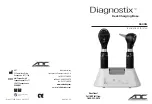
1. A SPECIAL THANK YOU
Congratulations on your purchase of an ADC
®
Diagnostix
TM
Desk Charging Base.
ADC
professional diagnostic products are the instruments of choice where
accuracy and dependability are critical.
This feature-rich instrument was designed to simplify physical exams and
non-invasive diagnostics. With proper use and care it will provide many years
of dependable service.
Read this booklet thoroughly before attempting to use your new ADC
Diagnostix
Desk Charging Base.
2. INTRODUCTION AND INTENDED USE
This manual is for the ADC
Diagnostix
Desk Charging Base. The charger base is
manufactured for use with ADC or compatible 2.5V or 3.5V power handles and
instrument heads. The base is designed to recharge compatible power handles.
If you have any questions, call our toll-free number or visit our website.
For contact information, see the last page of this instruction booklet.
Please note that the ADC
Diagnostix
Desk Charging Base is only suitable for
charging ADC
instruments operated with ADC
rechargeable batteries.
Do not use with any other equipment. To learn more, visit our website at:
www.adctoday.com.
3. CONTRAINDICTIONS
There are no known contraindictions. The device is only intended for the use
specified in the instructions for use.
Recommended distances between portable and mobile RF communications equipment
and the charging stations.
The charging station is intended for use in an electromagnetic environment in which radiated RF distur- bances are controlled. The customer or
user of the charging station can help prevent electromagnetic interference by maintaining a minimum distance between portable and mobile RF
communication equip- ment (transmitters) and the charging station as recommended below, according to the maximum output power of the
communications equipment.
For transmitters rated at a maximum output power not listed above, the recommended distance d in metres
(m) can be estimated using the equation applicable to the frequency of the transmitter, where P is the maxi- mum output power rating of the
transmitter in watts (W) according to the transmitter manufacturer.
NOTE 1:
At 80 MHz and 800 MHz, the distance for the higher frequency range applies.
NOTE 2:
These guidelines may not apply in all situations. The electromagnetic propagation is affected by absorption and reflection by
structures, objects and people.
Rated output power of the
transmitter (w)
d =12√P
0.01
d =1, 2√P
0.12
0.12
0.23
0.1
0.38
0.38
0.273
1
1.2
1.2
2.3
10
3.8
3.8
7.3
100
12
12
23
150 kHz to 80 MHz
80 MHz to 800 MHz
d =2, 3√P
800 MHz to 2,7 GHz
Separation distance according to the frequency of the transmitter (m)
3
14


























